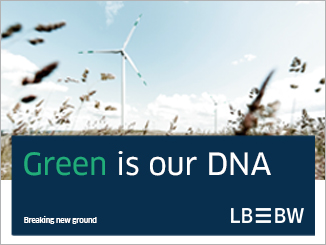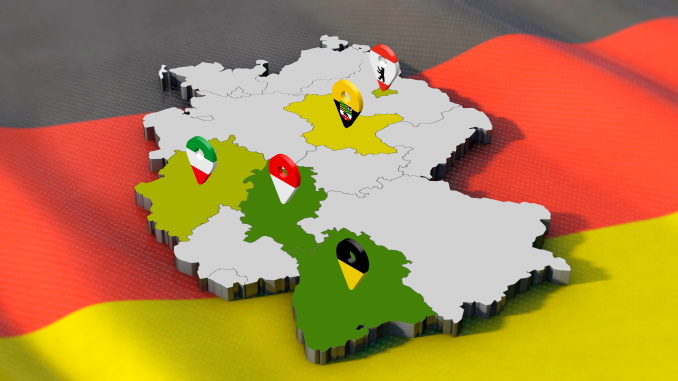
A pre-summer bout of green, social and sustainability issuance from Germany’s federal states highlighted their burgeoning activity in the market as well as the environmental and social tasks they face. Representatives of the five Länder to have issued GSS bonds spoke to Sustainabonds’ Neil Day about their rationale for entering the market, what make their frameworks distinctive, and how their issuance is evolving in light of market and regulatory developments.
Participants:
Elke Badack-Hebig, Head of Treasury, State of Berlin — Senate Department of Finance
Arnim Emrich, Head of Treasury, Ministry of Finance of the State of Baden-Württemberg
Kirsten Häger, Head of Sustainable Finance, Ministry of Finance of the State of Nordrhein-Westfalen
Markus Krause, Head of Treasury, Ministry of Finance of the State of Sachsen-Anhalt
Alexander Labermeier, Head of Treasury and Asset Management, Ministry of Finance of the State of Hessen
Neil Day, Managing Editor, Sustainabonds, and moderator
A pdf of this article can be downloaded here.
Neil Day, Sustainabonds: Before we discuss your specific green, social and sustainability (GSS) frameworks and issuance, perhaps we can discuss how sustainability is embedded in your state’s strategy — something investors focus on as much as the bond itself. What is driving your sustainability commitments and targets? How are you progressing? What impacts might recent geopolitical, pandemic and environmental developments have had?
Arnim Emrich, Baden-Württemberg: It’s a very valid question, especially in our case, because we really think of the green bond as just one element of the overall sustainability strategy of the state. We want to use green bond issuance to showcase all the activities of the state and the sustainability of state expenditure. Baden-Württemberg has a long-standing comprehensive sustainability strategy that has evolved over time and has led to numerous laws establishing targets. These targets go beyond the national level in many instances, as reflected in two recent examples.
One is our climate protection and adaptation law that was passed in parliament this spring, which requires the state to reach greenhouse gas neutrality by 2040, and the state administration to reach this goal by 2030. It includes many provisions to reach these targets, such as a monitoring registry of initiatives and a CO2 shadow pricing system for public buildings. It also includes sector targets, which have been the subject of heated debate at the national level and have been dialled down somewhat for now. Baden-Württemberg has decided to keep sector targets in this law, so the targets and related measures go beyond those at the national level.
A second example is that Baden-Württemberg in 2020 passed a law on biodiversity, including targets such as a minimum of 30% organic farming by 2030, a 50% reduction in chemical plant by-products, and the conservation of the orchid areas of the state.
Markus Krause, Sachsen-Anhalt: How sustainability is embedded in the state’s strategy was indeed one of the biggest questions we dealt with ahead of our inaugural social bond, especially in investor discussions. The topic of sustainability has various dimensions and is expressed in different ways in Sachsen-Anhalt. One overriding point is that the current coalition government decided to introduce in their coalition treaty one of the first sustainability budgets using the UN SDGs, meaning that expenditures are linked to them. This shows how sustainability considerations reach the highest political level, while allowing the impact of the government’s political goals to be measured from an ESG perspective. Since we in the capital markets team have some experience of targeting the SDGs, we are in close contact with the project teams. It’s a big initiative and I will be very happy when it is achieved.
Discussions around sustainability in the state started relatively early, already back in 2006, with the publication of an indicator report. Following several further steps, in 2018 we had a major transformation of our sustainability strategy, with the initial coupling of it to the SDGs. Last year we updated our strategy and published a new indicator report, also connecting these indicators with special goals the state aims to achieve until 2030. These include: significant CO2 reductions; increasing the share of renewables in energy consumption; strengthening the share of ecological agriculture; a greater focus on biodiversity; and the health of the state’s forests. We are also seeking to be aligned with developments at the federal level.
Finally, because of the Covid-19 pandemic, the state focused especially on the social side of sustainability. That led to major political discussions around social topics in recent years. However, in light of the aforementioned environmental tasks, climate change-related topics are coming to the fore.
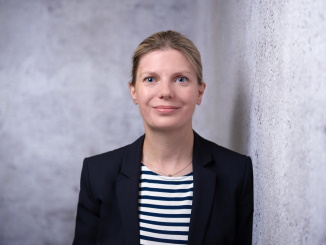 Kirsten Häger, Nordrhein-Westfalen: Nordrhein-Westfalen adopted its first sustainability strategy in June 2016. With this sustainability strategy, Nordrhein-Westfalen was the first German state that committed to implementing the Sustainable Development Goals. In September 2020, the state government of Nordrhein-Westfalen updated the sustainability strategy. The core of the updated sustainability strategy is a set of 67 goals and indicators, which are closely interlinked with the goals of the German federal government, and are based on the SDGs that the UN adopted in September 2015 with the 2030 agenda. Ecology, economy and social matters are taken into account equally within the Nordrhein-Westfalen sustainability strategy. This sustainability strategy is then the baseline for our sustainability bonds, thus we also link our projects to the SDGs. Matters like the pandemic and energy security have already been incorporated into our previous sustainability bonds.
Kirsten Häger, Nordrhein-Westfalen: Nordrhein-Westfalen adopted its first sustainability strategy in June 2016. With this sustainability strategy, Nordrhein-Westfalen was the first German state that committed to implementing the Sustainable Development Goals. In September 2020, the state government of Nordrhein-Westfalen updated the sustainability strategy. The core of the updated sustainability strategy is a set of 67 goals and indicators, which are closely interlinked with the goals of the German federal government, and are based on the SDGs that the UN adopted in September 2015 with the 2030 agenda. Ecology, economy and social matters are taken into account equally within the Nordrhein-Westfalen sustainability strategy. This sustainability strategy is then the baseline for our sustainability bonds, thus we also link our projects to the SDGs. Matters like the pandemic and energy security have already been incorporated into our previous sustainability bonds.
Nordrhein-Westfalen is proud to be ranked number two among European regional issuers by Moody’s ESG Solutions, with the top rating “advanced”, which reflects a score of 60 or more on a scale of 0 to 100. We are happy to have been able to improve over the years, most recently by one point compared with last year to now achieve 65.
Alexander Labermeier, Hessen: The state of Hessen introduced its sustainability strategy very early, in 2008, and the following year we established a target of carbon neutrality for the state administration by 2030, and for the state itself by 2045 — this is in line with the federal target. But declaring such political goals is one thing; delivering concrete action plans and measures and demonstrating your progress is another. We began with broad climate actions plans including a variety of measures, big and small.
The largest was to rebuild, reconstruct and refurbish our state buildings — the state has over 2000 buildings related to all its various tasks, so we embarked upon this goal early on, and we are now working towards making them fossil-free and working on Eco-Management and Audit Schemes (EMAS). This also reflects how we are acting as a state first, and only then asking our population and industries to follow, rather than asking them to act first — we are very clear that this is the right strategy.
In 2008 we had already set up a carbon dioxide balance sheet, which is audited and published annually. This is unique in Germany, but we believe that only by showing your track record can you demonstrate how far you have progressed and what still needs to be done. By 2020 we had reduced our carbon footprint by 64%, to 168,000 tonnes, but we have another 36% to go by 2030.
In 2022 we passed a climate action law featuring concrete steps to be implemented and followed by the state. Hessen is the only state where a referendum is needed to change the constitution and in 2018 we had a major initiative to amend the constitution including adding sustainability as a state objective. This was approved by 70% of the population, so there is very strong political protection on this front.
Our inaugural green bond in 2021 was a political task under the coalition agreement of the Christian Democrats and Green Party. We issued our second green bond this June, but while we are now acting as a green bond issuer, we acted as an investor in this field very early on. Firstly, we built up a state pension trust with an asset portfolio including only sustainable stocks, we then improved this, measuring its carbon footprint, and now, in combination with other German states like Baden-Württemberg, we are progressing further on this side, implementing a stock portfolio that follows Paris Agreement-aligned benchmarks. Our investors can then see that we have a holistic strategy, acting both as an investor and an issuer.
These are some of our key activities in the context of ESG, demonstrating our broad and long-standing sustainability strategy, and the great progress we have made.
Elke Badack-Hebig, Berlin: Berlin started out in 2016 with the development of a first sustainability profile. That year, the Berlin Energy Transition Act was passed, setting out the legal framework for ambitious climate protection. Berlin wants to become climate neutral by 2045 at the latest and we have already seen CO2 emissions fall around 50% in the period from 1990 to 2020. Why did we start at 1990? That was the first year after reunification and the first measurements for the whole surface area of the state of Berlin.
In the transition act, we defined the Berlin Energy & Climate Protection programme, BEK 2030, which is at the very heart of our everyday activity. It defines the fields of action for climate change mitigation — with respect to energy, buildings and transport, for example — and climate change adaptation — including topics such as housing, urban development and water. Rainwater management is one very important task, and forestry another — Berlin is a very green city, with forests covering more than 15% of our surface area, which is very different to other city states.
These climate-related tasks are anchored in targets at the international level, but the social sustainability that we pursue — and which is perhaps a different focus to some other German states — is more based on internal targets. We have many targets — regarding poverty reduction, health promotion, equal opportunities, for example — and these are already reflected in our budget, which is a social budget.
When it comes to social sustainability, three topics are in focus: education, affordable housing, and technical and social infrastructure. But it is important to note that while the target for affordable housing is very important, it does not fit into our sustainability bond. This is because we have many public companies engaged on this topic — the promotional bank and also the housing companies have printed social bonds for affordable housing themselves.
Day, Sustainabonds: To what extent is there cooperation and competition among the Länder in your GSS bond activity? How does it fit with the Federal level? Might we see further Länder join you five?
Krause, Sachsen-Anhalt: Our social bond provided a huge opportunity to engage in a deeper dialogue with my colleagues at the other states who had already been through the process. They understood the energy you need to arrive at a positive outcome, and were open in discussing important aspects, such as how to handle potential internal conflicts but also the external dialogues with banks and other counterparts. We already talk every week about market conditions, our issuance plans, and so on, and I found it very helpful that when working on the social bond I could lean on people who had been through the same struggles.
We have also been able to manage things such that everyone has their week to present their particular concept — maybe one focusing more on green, the other on social, and another putting the two together — and then go into the market, which was again very helpful. We saw Nordrhein-Westfalen with its sustainable bond, then we issued our social bond, and then the two green bonds. So in this respect, we are not competitors; it is a kind of sustainable path being taken by the states. We can perhaps work further in marketing ourselves collectively in this way, because we generated strong interest from investors in our various projects.
Badack-Hebig, Berlin: The Bund was the first-mover with a green bond, and it is a question of supporting the development of sustainable finance in Germany, which we are also contributing to. We will develop this strategy further — a kick-off meeting has been scheduled on 19 October with the federal government to discuss how to develop our strategies. So I wouldn’t say there’s any competition — it all fits together. It is important that we have coordination between the Länder and that within the group we share our experiences. For example, Nordrhein-Westfalen was the first-mover for sustainability bonds and we enjoyed a very good co-operation with them.
Labermeier, Hessen: There is some competition between the states, but we act in the same segment and cooperate very closely together in our normal issuance as well as in the sustainable market. The driver for us to issue an inaugural green bond was our coalition agreement, but at the same time Hessen is home to the financial centre of continental Europe, namely Frankfurt — with the ECB, Bundesbank and Eurex, for example, while the International Sustainability Standards Board (ISSB) took a large place in Frankfurt, too. So it makes sense that we support developments on the political side, but also from our working side, i.e. the financial market in Frankfurt.
We cooperated very closely with Finanzagentur on the green Bund, sharing the investor perspective, and we have very closely followed their process in our framework, using a refinancing approach. It makes sense if we all show the market that we cooperate very closely, rather than each state structuring and issuing in a completely different manner. We enjoy good exchanges with Finanzagentur and the other states on issuing green or sustainable bonds, and we do not see each other as competitors.
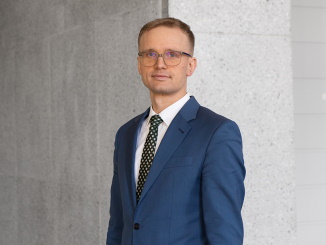 Emrich, Baden-Württemberg: As the others have said, there’s really no competition at the working level — we cooperate closely, exchanging ideas and coordinating issuance on a weekly basis. But there can certainly be some competition between the federal states at the political level, depending on which parties are in power. As Alexander noted, coalition agreements sometimes play a role in our issuance strategies — sometimes not — so there can be a political element to when and how a state proceeds, and that can come from a certain degree of competition, with politicians looking at what other states have done, and what their own state can still do.
Emrich, Baden-Württemberg: As the others have said, there’s really no competition at the working level — we cooperate closely, exchanging ideas and coordinating issuance on a weekly basis. But there can certainly be some competition between the federal states at the political level, depending on which parties are in power. As Alexander noted, coalition agreements sometimes play a role in our issuance strategies — sometimes not — so there can be a political element to when and how a state proceeds, and that can come from a certain degree of competition, with politicians looking at what other states have done, and what their own state can still do.
There’s also a separate, practical element that is a factor in whether or not all 16 states come out with green or sustainability bonds, namely the size of their budget. It’s a question of finding expenditures that you can document according to the Green Bond Principles or EU Taxonomy, and the smaller the state budget, the more difficult this becomes. Not only is reaching an appropriate issuance volume a challenge, but it is harder to justify the costs to the audit — with a benchmark size and 1bp or 2bp of greenium, you cover the costs of someone working on this quite quickly, but not with a small volume. This could keep small states from issuing at all.
It remains to be seen if other states adopt the example of Hessen, which was smart in looking not just at one year — as the Bund and ourselves do — because that allowed them to include more expenditures and hence reach a large size in their inaugural bond.
Häger, Nordrhein-Westfalen: We were the first German state and for a long time also the only German state issuing ESG bonds, which we started already in 2015. Thus, we also had to set up the first concept and were the first state to engage with banks, SPO providers and investors where we had to explain a lot. Now that more states have come to the market we can exchange with each other and are happy to do so and share our experience.
Day, Sustainabonds: What would you highlight as perhaps being distinctive about your particular issuance? Have you made any significant updates or changes to your framework lately?
Häger, Nordrhein-Westfalen: Since 2015, Nordrhein-Westfalen has issued 10 sustainability bonds with a total volume of more than €22bn. We updated our framework in 2021 to align it with our updated sustainability strategy. At the same time, we have taken a look at the first draft of the EU Taxonomy that had by then been published, and considered some of its elements. The framework is of course in line with the ICMA principles.
Our framework is particularly broad and comprises 14 ICMA categories, six of them social, and eight environmental. This reflects the broad responsibilities of a German state, and at the same time allows us to incorporate new projects when new developments like the pandemic occur without having to change the framework. Since our sustainability strategy is the baseline for our sustainability bonds, we map our projects to the SDGs and cover most of them. Investors appreciate how much information we deliver about our projects and how transparent our approach is. We receive very positive feedback from market participants.
Emrich, Baden-Württemberg: Baden-Württemberg’s green bonds provide investors with the opportunity to refinance state expenditures that contribute to each of the six objectives of the EU Taxonomy. Since our debut, we have based our issuance on the EU Taxonomy, initially on the working documents when it was in its nascent phase. From 2024 we will also publish Taxonomy alignment data, confirmed by the second party opinion, with the relevant shares in each category. Examples of these categories and relevant projects include: sustainable buildings, which is new buildings that are nearly zero-emission buildings or renovations of existing buildings that lead to energy efficiency improvements of more than 30%; investments in sustainable water infrastructure have also constituted a large share of investments and expenditure; and nature protection, including the orchid areas I mentioned earlier. Our framework has remained relatively unchanged in these key aspects, but we have updated it to reflect more explicitly the evolution of the EU Taxonomy from year to year.
The major change in 2023 was not in the framework itself, but in the green bond size, because we reached benchmark status for the first time and could issue a €600m bond this year.
Labermeier, Hessen: So far, we have taken a bond by bond approach in our issuance. Our aim is to deliver for investors an SPO specific to the framework of each bond. In our view, this contributes to greater transparency. In the framework for our inaugural bond, we had 20 projects refinancing expenditures from three years with a volume above €600m. For the second green bond, we have 30 projects totalling more than €1bn. We matched our projects to the Green Bond Principles as well as to the UN SDGs, and have started to implement the EU Taxonomy, in the first step by mapping them to the EU environmental objectives.
Looking at expenditures in different categories, a large portion is on eco-friendly public transport, over €800m. Hessen is the German state with the highest proportion of forests, so we have over €115m for forestation measures. We also have some large energy efficiency measures for buildings, but these were only a very small part of this bond because the renovation of state buildings is almost completed — the university will feature more in the next green bond. And then we have some interesting organic farming and water management projects. We are therefore presenting investors with a very broad variety of green expenditures, which is something they might not expect at the state level.
Krause, Sachsen-Anhalt: We try to find the starting point for our issuance in the challenges of the state. Sachsen-Anhalt has very particular challenges, because of its history, because of its geography, and because of the population. Reunification was a long time ago, but we still see its effects — it is visible in our economic structure and our demographics. We are a relatively aged state, for example, because labour issues after 1990 prompted many people to leave and never return.
We therefore came up with the expression “social fields of action”. These are derived from our sustainability strategy but also political strategy papers, and mean that we take in all the major challenges in our framework. Among these key topics are, for example; resilience through digitalisation; education and science; strengthening and deepening the labour market; and strengthening the healthcare system.
We have only 2.2m inhabitants, but they are spread across every part of the state, meaning that many live in rural areas. It can therefore be quite stressful to get an appointment for a specialist doctor, for example, or to find a hospital nearby. Meanwhile, our relatively old population means that diseases that may appear can have a greater impact that in other states. Vulnerable groups are therefore a focus of the state’s measures. And then we also have the experiences of the Covid-19 pandemic, of course, which made these activities an even higher priority.
We have combined these social fields of action that we developed with the general categories of the Social Bond Principles, because we wanted to be able to show a direct link to the project expenditures of the major challenges of the state, so that investors can clearly understand what we are trying to address, why these areas are so important to us, and for whom they are most relevant. To be honest, some major investors we talked to have no idea where Sachsen-Anhalt is, so we try to be as transparent and provide as much information as possible so that they have a better idea of what the state is about.
As the framework is very recent, we have no updates planned. We have a very clearly defined asset pool, not only relating to the past, but also the future. We therefore expect to be able to find further expenditures to include and then issue further transactions under this framework.
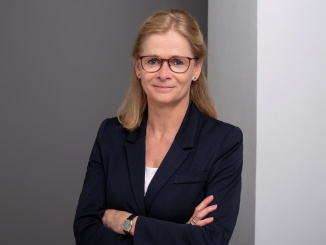 Badack-Hebig, Berlin: Our framework received an SPO in December 2022 ahead of our inaugural bond in February 2023, so everything is still up to date. As Alexander described in respect of Hessen, we adopt the same bond by bond approach. We have published our allocation report and we are currently working on our impact report.
Badack-Hebig, Berlin: Our framework received an SPO in December 2022 ahead of our inaugural bond in February 2023, so everything is still up to date. As Alexander described in respect of Hessen, we adopt the same bond by bond approach. We have published our allocation report and we are currently working on our impact report.
We follow the Green Bond Principles and the Social Bond Principles of ICMA, and our framework is aligned to the UN SDGs, contributing to 12, seven on the social side and five on the green side. We had 36 projects in the first bond, 18 social and 18 green.
If we have a look to the Green Bond Principles, we include seven out of the 10 project categories. Sustainable water and wastewater management are not included for the same reason as affordable housing that I mentioned earlier — these tasks are the responsibility of water companies, which themselves have green loans. On the Social Bond Principles side, we included five of the six project categories in the framework. Clean transportation has the biggest volume on the green side, while on the social side socio-economic advancement and empowerment is the largest.
This has all worked very well for us.
Day, Sustainabonds: Turning to the two most recent entrants into the GSS market, what is behind Berlin’s choice of the sustainability format and Sachsen-Anhalt going for social?
Badack-Hebig, Berlin: The framework allows for social bonds and green bonds. We decided to go with sustainability bonds to address the volume question that was discussed earlier. Social expenditures made up 75% of our inaugural €750m bond, so you can see that there is an issue of volume relating to green projects. If you want to avoid greenwashing, you have to choose your projects very carefully, and we only had €224m on the green side — not even the €300m that Baden-Württemberg reached in its first green bond. You need a volume well above €250m to achieve both a market size and a smooth allocation, which we have not yet been able to reach. Right now, the sustainability route is much more efficient for us, but perhaps we will have a green bond in the future — like other metropolises, we have so many topics to address in urban development — the heat-adapted city, the water-sensitive city, etc. Here we anticipate further developments in the coming years.
Krause, Sachsen-Anhalt: Our budget is far smaller than those of Baden-Württemberg or Nordrhein-Westfalen, for example, so we are not able to collect expenditures sufficient for full green bonds. Intel’s decision to build its European semiconductor production hub close to our capital could have a big impact on green-related state expenditures — but that is yet to be realised. We could perhaps combine social and ecological aspects into a sustainable bond. But I’m not sure that having a bond with, say, 80% social and 20% green would be the optimal way to approach investors.
However, we are active and flexible in our capital markets approach and issue private placements, EMTNs and commercial paper, so if we can produce a green project volume sufficient for those, why not combine it with that activity? Indeed, our aim is to integrate ESG aspects into nearly every issuance we do. My hope is that we have the social bonds on the one hand, but maybe green private placements or ECP on the other, addressing the different topics. It would be interesting to find out about Austria’s experience in this area, for example. It will be a big challenge, but I believe we should look at our other instruments and could perhaps reflect this in our next framework. It could also help other ministries integrate ESG into their work.
Day, Sustainabonds: To what extent is the EU Taxonomy — its detail and also potentially the EU Green Bond Standard (EUGBS) — relevant for you and a challenge? And would the mooted Social Taxonomy be a useful reference?
Emrich, Baden-Württemberg: Since our inaugural bond we have had the worthy ambition of Taxonomy-alignment. We have stuck to this, but it has become more of a burden to deal with than I had — perhaps naively — anticipated. There certainly have been a lot of micro challenges. The final delegated acts for the remaining objectives were published this year and our team has been looking at the projects related to biodiversity, water and so on, and have started to verify the do no significant harm (DNSH) criteria for these, after having already done so for climate mitigation and climate adaptation. We are therefore into the cumbersome details, for example, the DNSH criteria on water for buildings. There is not really an issue of buildings wasting water for us, but we must source the relevant data, and the amount of water that is flowing through a specific tap is not something that is readily available in the documentation of buildings, which makes it hard to prove that the DNSH criteria are fulfilled. So there are certainly issues that cause headaches. It is at times frustrating, because we understand that the intention to exclude harmful actions is good, but because there is fear of falling foul of the bureaucratic technical system, some auditors or SPO providers are playing it safe in their opinions, thereby creating outcomes that are not always in line with the aim of the Taxonomy, in my eyes. We are trying to make things work as best as possible. We will be transparent with investors, highlighting in our investor presentations cases where we have come to the conclusion that we don’t formally align with the Taxonomy but where we believe we are aligned with the spirit of the Taxonomy, so that they can see a matrix of eligibility, alignment and then also the reasons for non-alignment, and everyone can then make his or her own judgement on that.
 Labermeier, Hessen: Just to give you an example of how much work is involved: when we issue a normal state treasury bond, it takes us four days; when we issued our inaugural green bond, it took us more than a year. For the second green bond, we still have at minimum a half year of workload to issue a single bond. This shows how ambitious are the Taxonomy and the EU Green Bond Standard.
Labermeier, Hessen: Just to give you an example of how much work is involved: when we issue a normal state treasury bond, it takes us four days; when we issued our inaugural green bond, it took us more than a year. For the second green bond, we still have at minimum a half year of workload to issue a single bond. This shows how ambitious are the Taxonomy and the EU Green Bond Standard.
Our aim has been to build up a green benchmark curve, with a large benchmark in green format every two years. We have issued two benchmarks so far and have already published our impact reports on these, meaning that we have a very valid system of issuing and selecting projects. So I believe we could now take the next step towards the EU Taxonomy — even if large issuers like the EU itself and the Bund haven’t yet gone so far, which shows how complicated it is. It involves a lot of paperwork — we need to show the SPO very much technical data at the project level, which we may or may not have. Our approach has therefore as a first step been to match projects to the EU objectives, and now as a second step we are seeing how we can assimilate the requirements of the EU Taxonomy into our largest green bond projects. It’s an open question whether this will be manageable. You have to be very sure that you can prove your declared share of Taxonomy-aligned projects to avoid liability. The Taxonomy is driven by the EU to avoid greenwashing by companies, but its application to states was not considered. According to our constitution, we have to follow the law and already implement environmental impact assessments in all our activities, so the DNSH requirements mean that we have a double workload for every project.
Krause, Sachsen-Anhalt: While we have not referenced the EU Taxonomy and EUGBS in our social bond framework, we are following discussions and the direction of travel to understand what this might imply for the future, in particular with regards to project selection and especially reporting.
We are also already considering the EU Taxonomy when we are discussing assets with our building department, for example, with the state being responsible for police stations, courts, etc. We suggested that when they are planning new building work they take into account the EU Taxonomy and some of the new construction ideas that will help achieve the relevant targets, and that was a new concept for some of them. We hope we are helping to broaden the discussion and also that some of the state’s new buildings could be within the scope of the EU Taxonomy, so that we could maybe use some in a bond in the future.
Häger, Nordrhein-Westfalen: In line with our state’s sustainability strategy, Nordrhein-Westfalen issues sustainability bonds comprising a large range of both social and environmental projects. Of course, we follow the developments at the European level including the Taxonomy and tried to implement some of its elements. By doing so, we have been one of the pioneers in the market in the sub-sovereign segment.
For our last two issuances, we let our SPO provider assess the alignment of our environmental projects with the EU Taxonomy. Since most of our projects are social projects, the share of the bond that is fully aligned with the Taxonomy is relatively small. For our sustainability bond, we can only select projects out of our budget plan that have been approved by parliament. We only select projects that we are not obliged to do by federal law. Since our sustainability bond comprises so many projects with so many actors and involved parties, gathering the relevant data is quite time consuming or it might not even be available at all.
In addition, this year we have also tried, for the first time, a high level AAAQ analysis of our social projects in line with the proposed social taxonomy.
Badack-Hebig, Berlin: We are looking forward to having a Social Taxonomy one day, depending on if and how that develops, as it would then be possible for us to seek alignment in the same way that others target alignment on the green side. We have not been targeting Taxonomy-alignment for our green projects because of the volume question I mentioned earlier — it would be so much work for a small volume. Investors have also told us in one-on-one meetings that as the green share is less than 50%, our bond will not fit every green fund, but will instead be in social funds. We have nevertheless in our framework made clear the environmental objectives and different economic activities according to the EU taxonomy that our clean transportation category contributes to.
Day, Sustainabonds: Turning to your GSS issuance itself, what have been your latest experiences? How did they compare with your expectations? How is the market developing?
Badack-Hebig, Berlin: For our debut issue, we had a very intensive marketing process and it was a very different experience to our conventional bonds, as Alexander mentioned: it takes us four days for a conventional bond; the sustainability bond took from the beginning of January. The week before our issue, we had one-on-one sessions with investors, and these were very helpful, because we had a very high level of oversubscription — it was seven times oversubscribed with an order book of more than €5bn — and the discussions also gave us so much useful feedback. Our framework with the use of proceeds format and SPO is very transparent, providing a great deal of information for investors, and they told us that this was the right approach. We broadened our investor base, with ESG investors in our order book who were different than in our conventional bonds, including about half of those with whom we’d had one-on-one meetings. Achieving a greenium on this bond was not one of our objectives, but we had the chance to realise a greenium of 1bp at re-offer. We were happy about the whole process.
Häger, Nordrhein-Westfalen: This year we have issued our 10th anniversary bond with a volume of €2bn. We like to improve our sustainability bonds from year to year and react to feedback that we receive from investors. As I mentioned, this year we had the new element of the social taxonomy high level AAAQ analysis. And also, for the first time, we published impact and allocation data on our previous sustainability bonds in a computer readable format, as Excel files, on our website.
The issuance attracted a lot of demand, with a final order book exceeding €13bn, and more than two-thirds of the investors were classified as either light or dark ESG investors, according to our own classification.
Having a benchmark size for the issuances is very important. Of course, that’s easier for Nordrhein-Westfalen than for other states because we are the biggest of the German states, with 18m citizens, while the concept of having a sustainability bond rather than a pure green or pure social bond also allows us to have more projects and a higher volume for our bonds.
Looking back, my impression at the beginning of our issuances was that there were certain investors who preferred green over social projects. But I think that this changed during the pandemic, where some of the topics like health, for example, became very important. We have a majority of social projects in our sustainability bond, and this simply reflects the tasks that a German state has, which are in many cases social, like education and health, for example.
Labermeier, Hessen: Our latest experience was very similar to the inaugural one. €1bn was the largest green bond a state has issued, which is a big attraction for investors. We kicked off with a press conference with the minister, demonstrating the strong political commitment to this process, and had two Europe-wide investor calls as well as 17 individual calls. These went very deep into our offering at project level, which we can provide a high level of transparency for because we have the complete set-up ready before issuance, meaning that we can also show the full impact assessment already — this was one point investors remarked upon very favourably.
Compared with a normal bond, we have double the amount of investors by number, as well as a large oversubscription. We also reached a greenium, 2bp in the first green bond and in our latest it was 1bp, which is in line with a reduced greenium at the federal level — it depends on market conditions as well as how green bond supply compares with investors’ expectations.
Normal bonds don’t get such attention in the press, at conferences, and so on, so green bonds not only contribute to sustainability ambitions, but another major advantage is that they generate interest in your normal bonds.
 Krause, Sachsen-Anhalt: The inaugural social bond in June was a great success for us, much more successful than our usual issuance. Our major aim was to broaden our investor base, and we certainly achieved that, with more than 80 different investors, and the huge order book allowed us to achieve successful pricing. It was very time-consuming and quite stressful — we had close to 20 one-on-ones in a week and two global investors calls — but we reached investors we had never seen before, giving us a first opportunity to speak to them, which was invaluable — we learned a lot from their questions, what they are looking for. The focus on the social aspect was a little bit new to some investors, but many of them liked the clear linkage from the expenditures to the state’s challenges, and for us it has proven to be a USP that was very helpful in the transaction — which is another reason to keep any green capital markets activity separate. Investors also gave their opinions on reporting, which KPIs are interesting and so on, and hopefully we can discuss this feedback with our internal counterparts — ministries already have reporting obligations to parliament in respect of the special fund behind our framework and, together, we could develop and improve this further. All this should be very helpful for the development of our issuance in the future.
Krause, Sachsen-Anhalt: The inaugural social bond in June was a great success for us, much more successful than our usual issuance. Our major aim was to broaden our investor base, and we certainly achieved that, with more than 80 different investors, and the huge order book allowed us to achieve successful pricing. It was very time-consuming and quite stressful — we had close to 20 one-on-ones in a week and two global investors calls — but we reached investors we had never seen before, giving us a first opportunity to speak to them, which was invaluable — we learned a lot from their questions, what they are looking for. The focus on the social aspect was a little bit new to some investors, but many of them liked the clear linkage from the expenditures to the state’s challenges, and for us it has proven to be a USP that was very helpful in the transaction — which is another reason to keep any green capital markets activity separate. Investors also gave their opinions on reporting, which KPIs are interesting and so on, and hopefully we can discuss this feedback with our internal counterparts — ministries already have reporting obligations to parliament in respect of the special fund behind our framework and, together, we could develop and improve this further. All this should be very helpful for the development of our issuance in the future.
Emrich, Baden-Württemberg: It is clear that the benchmark size we used for the first time has given us a further boost, especially of international interest. We know that it is very common for large investors to have rules preventing investment in issuances below €500m — we have such a rule, too, on the asset management side — and so in previous years some of the very large international investors were excluded, but this year they came in. We had a very diverse €5bn order book including 127 investors and eight times oversubscription. We had very good bilateral discussions, particularly in Scandinavia where they have large pension funds with explicit green mandates. We also saw international investors who had never invested in Baden-Württemberg but were attracted by the green bond, and then realised that they wanted to create a bucket for Baden-Württemberg in general. So I can confirm Alexander’s comments — it’s a very good way for us as a rare frequent issuer, I would say, to engage with these investors, and then when they see our name on Bloomberg for them to say, OK, I bought the green bond last year, now I can buy something else from them. At the working level, that’s a big advantage — you can’t quantify it, but I’m sure it has a financial impact.
On the price side, I can confirm what the federal level has seen, with 1bp-2bp of greenium in the first and the second green bonds — we don’t have a twin structure like the Bund, so it’s always an estimate, but it’s important because if the court of audit looks at this from a mere financial perspective and we don’t have any basis point advantage, they, at least, will become more critical.
Day, Sustainabonds: Looking ahead, what can investors expect from you, regarding issuance and any evolution in strategy?
Badack-Hebig, Berlin: We have communicated that a sustainability bond is planned every two years. As we decided to build a curve with sustainability bonds as well as conventional bonds, we will follow up on that.
In Berlin, the €5bn special fund for climate protection, resilience and transformation should be passed at the end of November and the ministries involved will have to define a uniform methodology to be used for the evaluation of the proposed measures. We can then discuss this with our finance minister and look closely at whether we can perhaps open our framework and go well beyond the volumes of we have so far achieved, and perhaps one day create a green bond from these expenditures.
In the meantime, at the working level we are developing the impact reporting for the inaugural sustainability bond and progressing step by step in our work.
Labermeier, Hessen: As I mentioned, we plan to build out a green benchmark curve with issuances every two years to show investors that we are in the market on a regular basis. This is also quite a good way for us to handle the workload and to collect two years of green expenditures, large expenditures for only around 30 projects to make it manageable. I expect environmental expenditures to rise greatly in future, so the next bond could even be larger than €1bn.
Krause, Sachsen-Anhalt: Our issuance will depend on the volume of the defined asset pool. In our planning, we see the possibility of issuing two other social bonds under the current framework. We plan to then amend the framework and open it to not only the Corona special fund, but also projects under our annual budget. It will then be more flexible, and the variety will be much greater.
Häger, Nordrhein-Westfalen: Our plan is to continue to issue sustainability bonds. Our state sustainability strategy is updated once per legislative period, which normally last five years, and we are currently in the update process, with all ministries involved. Frameworks are not set in stone forever, of course, but need to be updated from time to time to be in line with market standards and best practices.
Emrich, Baden-Württemberg: We will continue to issue annually and to do so in benchmark size now, because there is just a natural evolution in expenditures — due to the required standards for energy efficiency and so on, more and more buildings, for example, fit the criteria. So we will have an increase in the large projects that are eligible, and also we anticipate expenditure on additional projects based on political decisions in the preceding year.
It’s an open question whether or not we will at some point also switch to the EU Green Bond Standard. That is simply dependent on the evolution of the project portfolio evolution and how much of it is ultimately Taxonomy-aligned. There could be a decision in that direction, but then we would have to remove some of the projects to fit the new standard, and we would try to do that only if we can remain at benchmark size.
Sustainabonds conducts all research and writing independently to maintain the full editorial integrity of the publication.
As a supporter of Sustainabonds, LBBW is facilitating a series of interviews with leading players in ESG and the green, social and sustainability bond markets.

